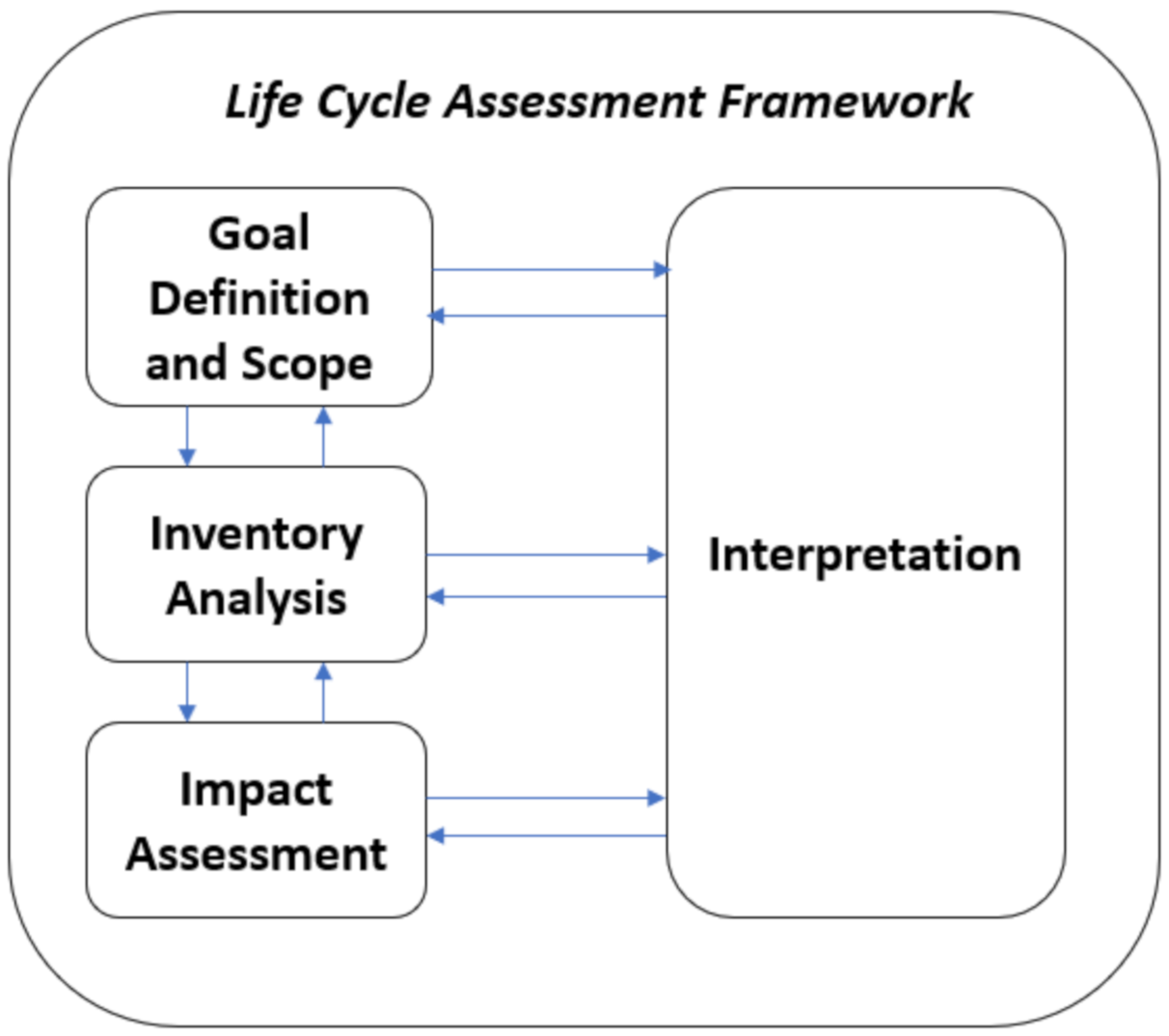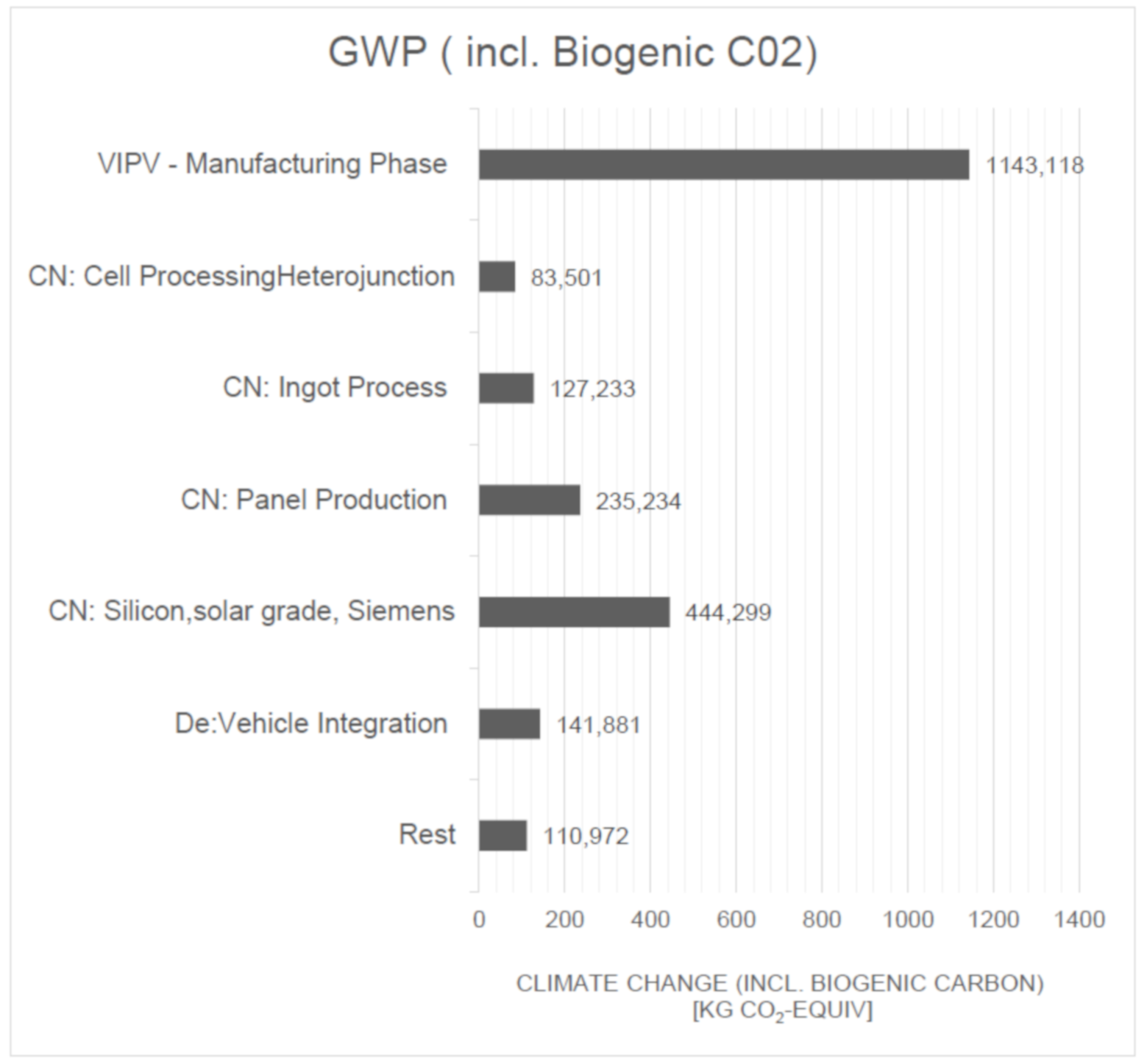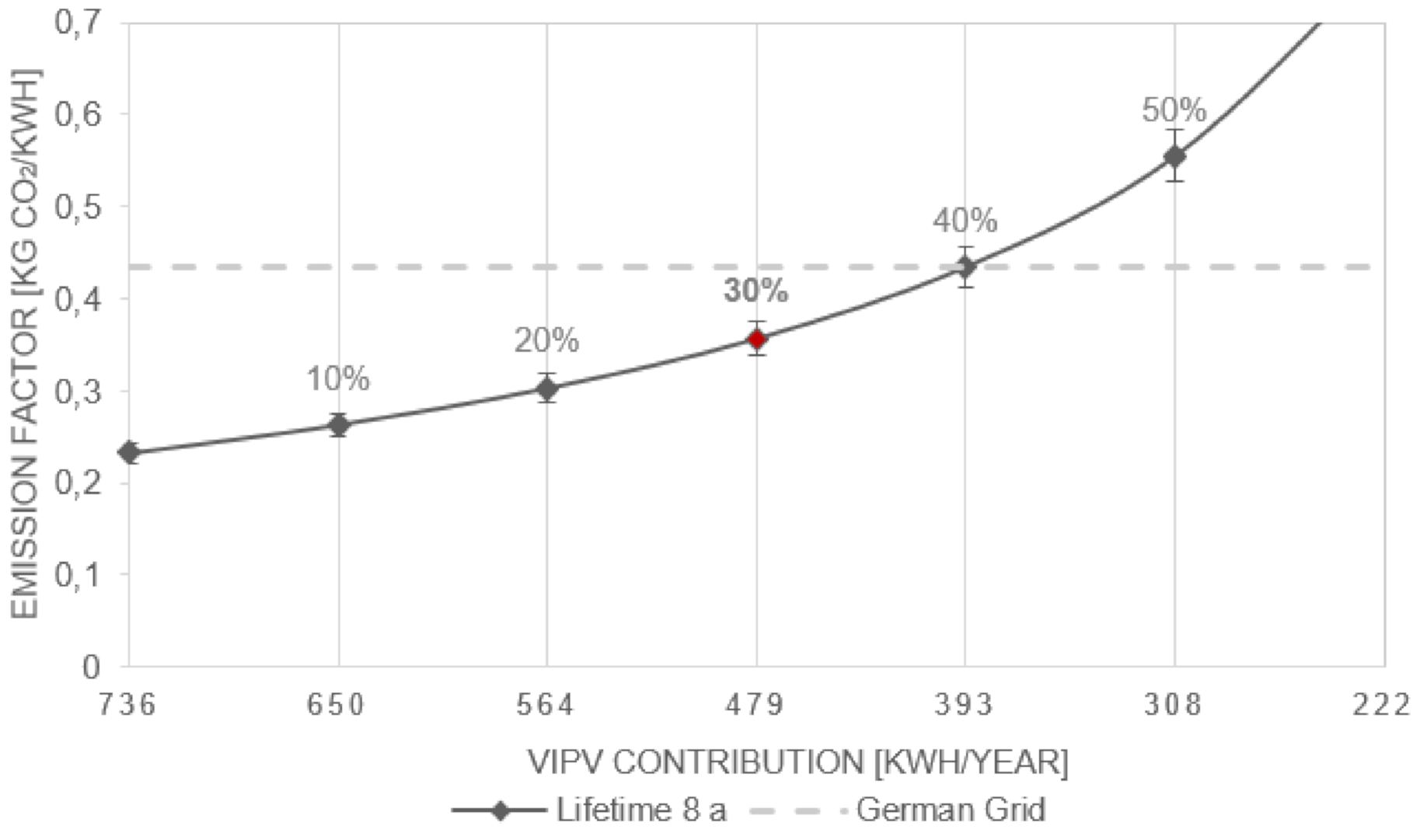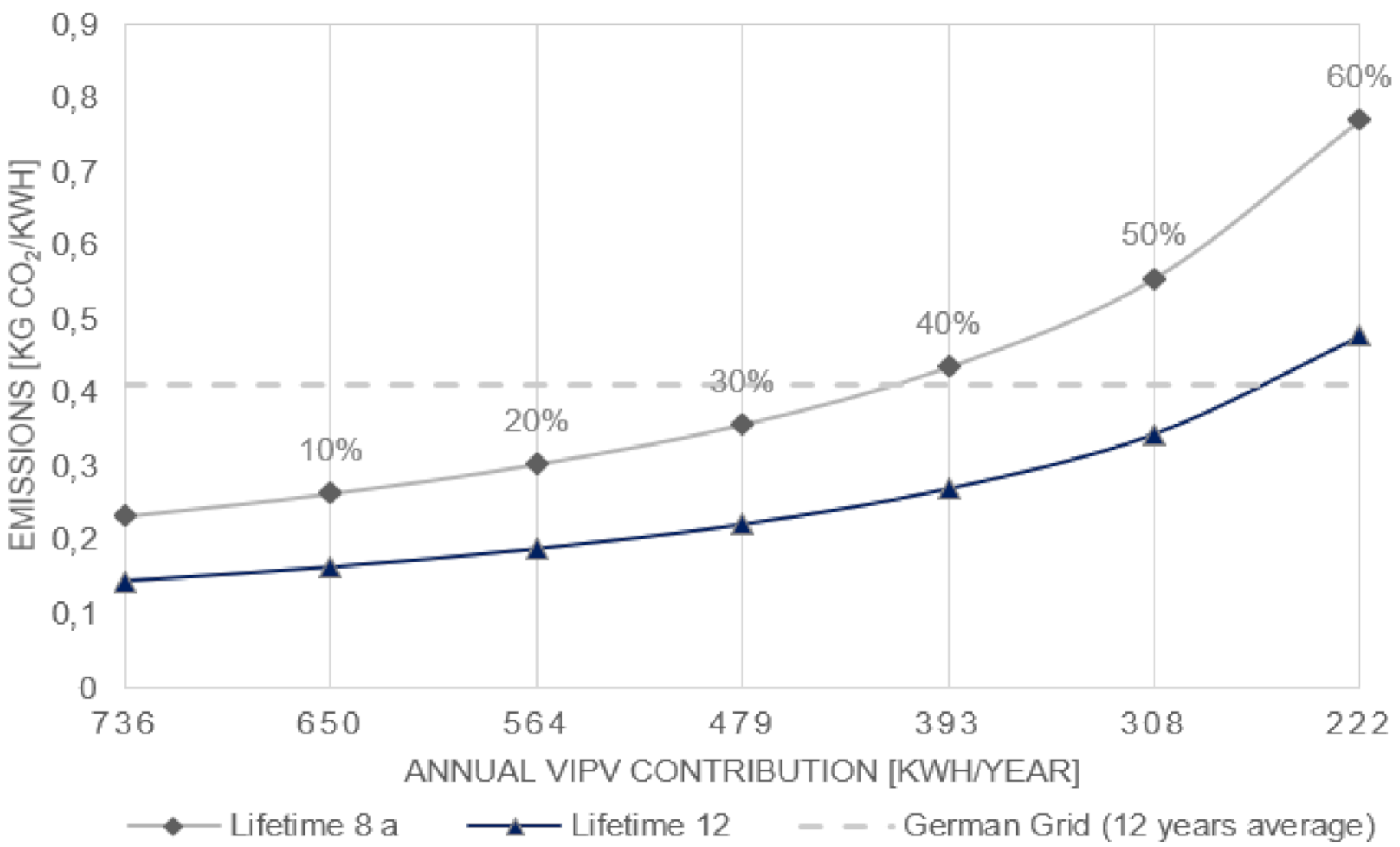Environmental Impacts of Integrated Photovoltaic Modules in Light Utility Electric Vehicles
Abstract
1. Introduction
2. Method and Data
2.1. Life Cycle Assessment Method
2.2. Functional Unit, Goal, and Scope
2.3. Input Parameters for the Life Cycle Inventory
2.4. Input Parameters for the Energy Flow Model
2.5. Input Parameters of the Grid Charge
2.6. Reliability of the Data
3. Results
3.1. Manufacturing Process of the VIPV
3.2. Operation Phase of the VIPV
3.3. Comparison to the Emissions of the Grid Charge
3.4. Sensitivity Analysis
4. Discussion and Conclusions
Author Contributions
Funding
Acknowledgments
Conflicts of Interest
References
- European Environment Agency (EEA). Progress of EU Transport Sector Towards Its Environment and Climate Objectives. 2018. Available online: https://www.eea.europa.eu/themes/transport/term/term-briefing-2018 (accessed on 30 September 2020).
- Helmers, E.; Dietz, J.; Hartard, S. Electric car life cycle assessment based on real-world mileage and the electric conversion scenario. Int. J. Life Cycle Assess. 2015, 22, 15–30. [Google Scholar] [CrossRef]
- New Energy and Industrial Technology Development Organization. NEDO, PV-Powered Vehicle Strategy Committee. 2018. Available online: https://www.nedo.go.jp/content/100885778.pdf (accessed on 30 September 2020).
- Rizzo, G. Automotive application of solar energy. In Proceedings of the 6th IFAC Symposium Advances in Automotive Control, Munich, Germany, 12–14 July 2010. [Google Scholar]
- Araki, K.; Ji, L.; Kelly, G.; Yamaguchi, M. To Do List for Research and Development and International Standardization to Achieve the Goal of Running a Majority of Electric Vehicles on Solar Energy. Coatings 2018, 8, 251. [Google Scholar] [CrossRef]
- International Organization for Standardization. Environmental Management—Life Cycle Assessment—Requirements and Guidelines (ISO 14044:2006 + Amd 1:2017); German Version EN ISO 14044:2006; ISO: Geneva, Switzerland, 2006. [Google Scholar]
- Frischknecht, R.; Itten, R.; Sinha, P.; de Wild-Scholten, M.; Zhang, J. Life Cycle Inventories and Life Cycle Assessments of Photovoltaic Systems, IEA PVPS Task 12, Subtask 2.0; Life Circle Assessment Report IEA-PVPS 12; International Energy Agency: Paris, France, 2015. [Google Scholar]
- Louwen, A.; Van Sark, W.; Schropp, R.E.I.; Faaij, A. A cost roadmap for silicon heterojunction solar cells. Sol. Energy Mater. Sol. Cells 2016, 147, 295–314. [Google Scholar] [CrossRef]
- Olson, C.; de Wild-Scholten, M.; Scherff, M. Life Cycle Assessment of Hetero-junction Solar Cells. In Proceedings of the 26th European Photovoltaic Solar Energy Conference and Exhibition, Hamburg, Germany, 5–6 September 2011. [Google Scholar]
- Louwen, A.; van Sark, W.; Turkenburg, W.C.; Schropp, R.; Faaij, A.C. R&D Integrated Life Cycle Assessment: A Case Study on the R&D of Silicon Heterojunction (SHJ) Solar Cell Based PV Systems. In Proceedings of the 27th European Photovoltaic Solar Energy Conference and Exhibition, Frankfurt, Germany, 23–27 September 2012; pp. 4673–4678. [Google Scholar]
- Hacker, F.; Waldenfels, R.; Moschall, M. Wirtschaftlichkeit von Elektromobilität in Gewerblichen Anwendungen. Betrachtung von Gesamtnutzungskosten, Ökonomischen Potenzialen und Möglicher CO2EQ—Minderung im Auftrag der Begleitforschung zum BMWi Förderschwerpunkt IKT für Elektromobilität; Öko-Institut: Berlin, Germany, 2015. [Google Scholar]
- Icha, P. Entwicklung der Spezifischen Kohlendioxid-Emissionen des Deutschen Strommix in den Jahren 1990–2018. 2019. Available online: https://www.umweltbundesamt.de/sites/default/files/medien/1410/publikationen/2019-04-10_cc_10-2019_strommix_2019.pdf (accessed on 30 September 2020).
- Bundesnetzagentur für Elektrizität, Gas, Telekommunikation, Post und Eisenbahnen. SMARD. 2020. Available online: https://www.smard.de/home (accessed on 22 June 2020).
- May, J.F.; Kanz, O.; Schürheck, P.; Fuge, N.; Waffenschmidt, E. Influence of usage patterns on ecoefficiency of bat-tery storage systems for electromobility and home storage. In Proceedings of the 3rd Product Lifetimes and the Environment Conference, Berlin, Germany, 18–20 September 2019. [Google Scholar]
- Memmler, M.; Lauf, T.; Schneider, S.; Dessau-Roßlau, U. Emissionsbilanz Erneuerbarer Energieträger—Bestimmung der Vermiedenen Emissionen im Jahr 2017. 2018. Available online: https://www.umweltbundesamt.de/sites/default/files/medien/1410/publikationen/2018-10-22_climate-change_23-2018_emissionsbilanz_erneuerbarer_energien_2017_fin.pdf (accessed on 30 September 2020).







| Parameter | Based on | Comment | |
|---|---|---|---|
| Wafer | Type: n-type c-Si | (b) | Wafer (Solar Grade) |
| Thickness: 180 nm | (a) | Wafer thickness | |
| Cell | Technology SHJ c-Si | SHJ cell processing adopted due to STREET requirements, μc-SiOx:H | |
| Area: 239 mm2 | (a) | 156 × 156 mm2 | |
| Efficiency: 22.5% | (c) | Describes the efficiency of the solar cells | |
| Panel | Efficiency: 19.7% | (c) | Describes the efficiency of the solar cells |
| Glass thickness: 2 mm | (c) | The thickness of the solar glass used on the front side of the solar cell | |
| Back: EVA Back Foil | (a) | EVA back foil configurations based on the Guideline | |
| Cell number per panel: 72 | (b) | Standard-based on the Guideline | |
| Vehicle Integration | Panel Number: 3 Total PV Area: 4.8 m2 PVCU Number 3 | (b) | |
| Mounting: on the rooftop Integration with Bosch Profiles |
| Process Step | Material | Description |
|---|---|---|
| Metallization front | Ag print | Screenprint |
| TCO | ITO | Sputtering of indium-tin-oxide |
| Emitter | a-Si: H (p) | ALD—atomic layer deposition |
| Passivation | a-Si:H (i) | Deposited by PECVD |
| BSF | a-Si:H (n) | Back surface field |
| Metallization back | Ag print | Screenprint |
| Parameter | Value | Unit |
|---|---|---|
| Capacity | 930 | Wp |
| Efficiency | 19.7 | % |
| Degradation | 0.7 | % |
| Operation lifetime | 8 | a |
| Location | Cologne (50.938, 6.954) | Lat/Lon |
| Database | PVGIS-CMSAF | / |
| Loss Coefficient | Changes in Output (%) |
|---|---|
| MPPT loss | −5 |
| Temperature/low irradiance | −9 |
| DC/DC conversions | −5 |
| DC charging/discharging loss | −2 |
| Average shadowing factor | −30 |
| Electricity Source | (g CO2 eq./kWh) | Reference |
|---|---|---|
| Biomass | 272 | [15] |
| Hydropower | 3 | [12] |
| Pumped hydro | 26 | |
| Wind offshore | 6 | |
| Wind onshore | 11 | |
| Photovoltaics | 67 | |
| Geothermal | 192 | |
| Lignite | 1142 | |
| Coal | 815 | |
| Natural gas | 374 | |
| Nuclear | 32 | [14] |
| German mix average | 486 | [12] |
| Process | Data Source | Quality | Comment | Flow Score |
|---|---|---|---|---|
| Feedstock, ingot, wafer production | (Frischknecht et al. 2015) Material flow: Ecoinvent database | Primary data, measured | High variability of process data, low uncertainty, verified data based on measurements with less than 6 years of difference | 2 |
| Wafer cleaning, texturing, PECVD of a-Si layers, TCO deposition, contacting, wiring | (Louwen et al. 2016; Louwen et al. 2012b; Olson et al. 2013) Material flow: Ecoinvent database | Primary data, measured, Ecoinvent processes updated based on updated data | Low variability of process data, low uncertainty, based on measurements with less than 6 years of difference | 1 |
| PVCU | Expert judgement—continental material flow: Ecoinvent database | Primary data, adjusted and verified by the STREET experts | Low variability of process data, higher uncertainty, verified by STREET Experts, less than 6 years of difference | 2 |
| Module assembly | (Frischknecht et al. 2015) Material flow: Ecoinvent database | Primary data, measured | Low variability, higher uncertainty, verified precise data based on measurements with less than 6 years of difference | 2 |
| Vehicle integration | Expert judgment: StreetScooter Material flow: Ecoinvent database | Estimated data based on metadata, verified by the STREET concept | High variability, high uncertainty, documented estimate, verified by STREET Experts, less than 6 years of difference | 3 |
| Operation | (PV-Powered Vehicle Strategy Committee 2019) Material flow: Ecoinvent database | Estimated data based on metadata, lacking measurements of PV output and maintenance | High uncertainty, high variability, documented estimate, verified by STREET Experts, less than 6 years of difference | 3 |
| Parameter | Value | Unit |
|---|---|---|
| Average yield in urban area | 936 | (kWh/kWp) |
| Average annual VIPV electricity production on board | 479 | (kWh/year) |
| Total production VIPV | 3738 | (kWh) |
© 2020 by the authors. Licensee MDPI, Basel, Switzerland. This article is an open access article distributed under the terms and conditions of the Creative Commons Attribution (CC BY) license (http://creativecommons.org/licenses/by/4.0/).
Share and Cite
Kanz, O.; Reinders, A.; May, J.; Ding, K. Environmental Impacts of Integrated Photovoltaic Modules in Light Utility Electric Vehicles. Energies 2020, 13, 5120. https://doi.org/10.3390/en13195120
Kanz O, Reinders A, May J, Ding K. Environmental Impacts of Integrated Photovoltaic Modules in Light Utility Electric Vehicles. Energies. 2020; 13(19):5120. https://doi.org/10.3390/en13195120
Chicago/Turabian StyleKanz, Olga, Angèle Reinders, Johanna May, and Kaining Ding. 2020. "Environmental Impacts of Integrated Photovoltaic Modules in Light Utility Electric Vehicles" Energies 13, no. 19: 5120. https://doi.org/10.3390/en13195120
APA StyleKanz, O., Reinders, A., May, J., & Ding, K. (2020). Environmental Impacts of Integrated Photovoltaic Modules in Light Utility Electric Vehicles. Energies, 13(19), 5120. https://doi.org/10.3390/en13195120







